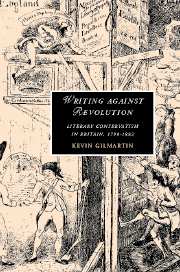Book contents
- Frontmatter
- Contents
- Illustrations
- Acknowledgments
- List of abbreviations
- Introduction: Reconsidering counterrevolutionary expression
- 1 In the theater of counterrevolution: loyalist association and vernacular address
- 2 “Study to be quiet”: Hannah More and counterrevolutionary moral reform
- 3 Reviewing subversion: the function of criticism at the present crisis
- 4 Subverting fictions: the counterrevolutionary form of the novel
- 5 Southey, Coleridge, and the end of anti-Jacobinism in Britain
- Notes
- Bibliography
- Index
- CAMBRIDGE STUDIES IN ROMANTICISM
5 - Southey, Coleridge, and the end of anti-Jacobinism in Britain
Published online by Cambridge University Press: 22 September 2009
- Frontmatter
- Contents
- Illustrations
- Acknowledgments
- List of abbreviations
- Introduction: Reconsidering counterrevolutionary expression
- 1 In the theater of counterrevolution: loyalist association and vernacular address
- 2 “Study to be quiet”: Hannah More and counterrevolutionary moral reform
- 3 Reviewing subversion: the function of criticism at the present crisis
- 4 Subverting fictions: the counterrevolutionary form of the novel
- 5 Southey, Coleridge, and the end of anti-Jacobinism in Britain
- Notes
- Bibliography
- Index
- CAMBRIDGE STUDIES IN ROMANTICISM
Summary
Robert Southey and Samuel Taylor Coleridge came into their own as vigorous public critics of radicalism and as defenders of the established Church and unreformed constitution during a sustained revival of radical fortunes that began in the first decade of the nineteenth century with the emergence of Sir Francis Burdett's Westminster reform organization and the radicalization of William Cobbett, and then culminated more threateningly in the post-war era of the unstamped weekly press and mass public agitation for parliamentary reform. If the “cry about Jacobinism” was arguably outmoded by the end of 1790s, sporadic outbreaks of political violence continued right through the era of Luddism and Peterloo, and flexible new practices of popular organization and expression clearly drew on the example of Paine and the London Corresponding Society. In taking up the public campaign against subversion, Southey and Coleridge joined their “Lake School” friend and collaborator William Wordsworth in repudiating early radical sympathies, and drew the scorn of a younger generation of more liberal poets and essayists including Shelley, Keats, Byron, Hazlitt, and Leigh Hunt. The generational rifts that emerged here still shape British romantic studies, particularly where the timing and intensity of a retreat from radicalism remain matters of critical concern. In closing this study of writing against revolution with the conservative careers of Southey and Coleridge, I am less concerned about the contrast with early radicalism than about the way both writers sought to revise and extend established patterns of counterrevolutionary expression, in order to establish more secure conditions for their own combative literary enterprise.
- Type
- Chapter
- Information
- Writing against RevolutionLiterary Conservatism in Britain, 1790–1832, pp. 207 - 252Publisher: Cambridge University PressPrint publication year: 2007
- 2
- Cited by



